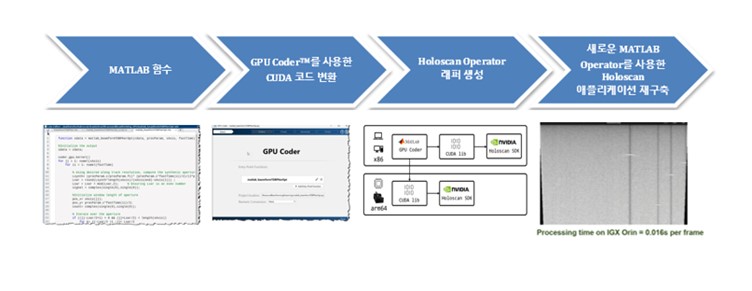엔비디아 홀로스캔 플랫폼에서 기존의 매트랩 알고리즘 코드베이스를 사용해 AI 탑재 애플리케이션 개발 및 배포가 가능해져 의료 부문 소프트웨어 워크플로우의 개발이 가속화 될 것으로 기대된다.
의료 부문 SW 워크플로우 개발 가속화
엔비디아 홀로스캔 플랫폼에서 기존의 매트랩 알고리즘 코드베이스를 사용해 AI 탑재 애플리케이션 개발 및 배포가 가능해져 의료 부문 소프트웨어 워크플로우의 개발이 가속화 될 것으로 기대된다.
테크니컬 컴퓨팅 소프트웨어 분야의 선도적인 개발업체 매스웍스는 9일 엔비디아(NVIDIA)의 의료 기기 구축을 위한 실시간 AI 컴퓨팅 소프트웨어 플랫폼인 엔비디아 홀로스캔(NVIDIA Holoscan)에서 매트랩(MATLAB)을 사용할 수 있는 통합 기능을 발표했다.
해당 기능을 통해 의료기기 엔지니어들은 실시간 데이터 처리와 추론을 위해 기존의 매트랩 알고리즘과 함수를 GPU 가속 엔비디아 홀로스캔 오퍼레이터(Holoscan Operator)로 래핑 하여 스트리밍 데이터를 분석하고 시각화 애플리케이션의 개발 및 배포를 가속화할 수 있다.
의료기기 엔지니어는 최첨단 소재와 전자기기 활용기술의 속도감 있는 혁신과 더불어 복잡하게 변화하는 국제 규제를 준수해야 한다. 이로 인해 많은 기기가 시장에 출시된 지 얼마 지나지 않아 구형이 되었고, 소프트웨어 의료기기(SaMD, Software as Medical Device)의 등장을 촉진시켰다.
‘소프트웨어 의료 기기(SaMD : Software as a Medical Devices)’는 하드웨어에 종속되지 않고 의료 기기의 사용 목적에 부합하는 기능을 가지며 독립적인 형태의 소프트웨어만으로 이뤄진 의료 기기를 말한다.
엔지니어는 소프트웨어 의료기기가 시장에서 지속적인 경쟁력을 유지할 수 있도록 소프트웨어 정의 워크플로우를 개발하여 초기 배포 이후의 추가 소프트웨어 기능을 통합할 수 있게 해야 한다.
데이비드 뉴올니(David Niewolny) 엔비디아 의료 기술 부문 사업 개발 책임자는 “의료 기술 산업은 인공 지능에 의해 혁신을 거듭하고 있다”며 “엔비디아와 매스웍스는 의료 등급의 엔비디아 홀로스캔 플랫폼 내에서 성장 중인 매트랩 개발 커뮤니티에 호환성 높은 개발 환경을 제공함으로써 의료 기술 분야의 AI 기반 혁신을 가속화하고 있다”고 말했다.
엔비디아 홀로스캔은 센서 처리 플랫폼으로, 실시간 인사이트를 제공하는 AI 및 고성능 컴퓨팅 애플리케이션의 개발 및 배포를 간소화한다.
또한 엣지에서 스트리밍 데이터의 확장 가능한 소프트웨어 정의 처리에 필요한 풀 스택 인프라를 제공해 최신 AI 애플리케이션을 임상 환경에 도입할 수 있도록 지원한다.
의료기기 엔지니어는 홀로스캔과 매트랩의 통합 기능을 통해 영상 및 신호 처리, 필터링, 변환, 딥러닝 알고리즘과 관련된 기존의 내장된 행렬 연산과 복잡한 툴박스 함수를 사용할 수 있다.
매트랩으로 홀로스캔 파이프라인을 구현하려면 매트랩 함수 생성, GPU 코더(GPU Coder)를 통한 가속화된 CUDA 코드 생성, 홀로스캔 오퍼레이터 래퍼 생성 및 새로운 매트랩 오퍼레이터(MATLAB Operator)를 사용한 홀로스캔 애플리케이션 재구축의 4 단계를 거쳐야 한다. 이러한 과정으로 구축된 소프트웨어 정의 워크플로우는 의료기기를 위해 완벽히 작동하며, 매트랩과 홀로스캔의 추가적인 통합 검증 및 확인 기능을 통해 IEC 62304 등의 산업 규정 및 표준을 준수하도록 할 수 있다.
데이비드 리치(David Rich) 매스웍스 제품 마케팅 부서장은 “이제 엔지니어들은 엔비디아 홀로스캔을 통해 매트랩 함수를 작성하고 수천 배 더 빨리 실행할 수 있다”며 “수백만 명의 고객이 산업 규정과 표준을 준수하는 제품을 설계, 개발 및 테스트하고자 하는 가운데, 업계 리더인 엔비디아와의 협업으로 의료 기기 혁신을 주도할 수 있게 됐다”고 말했다.
